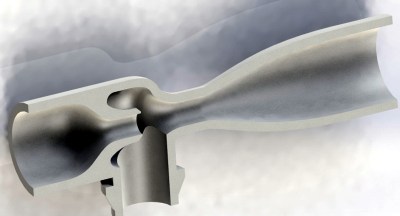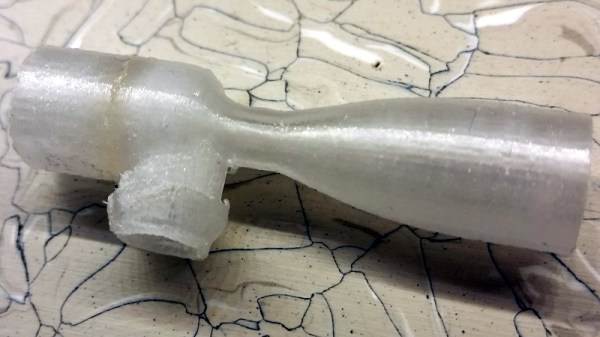Venturi pumps, commonly referred to as aspirators, are a fantastic way of moving around things which you might not want spinning around inside of a pump, and one of the easiest ways to create a vacuum. According to his research, [Tuval Ben Dosa] believed such a device would be a good way to move corrosive gasses which would normally eat up a blower fan; all he had to do was figure out how to 3D print one to his specifications.
 Put simply: if you take a “T” shaped pipe and pass a fluid (such as air or water) through the straight section, a vacuum will be created on the shorter side due to the Venturi effect. As long as you don’t mind the substance you wish to pump getting mixed into your working fluid, it’s a simple way to bring something “along for the ride” as the fluid makes its way through the pipe.
Put simply: if you take a “T” shaped pipe and pass a fluid (such as air or water) through the straight section, a vacuum will be created on the shorter side due to the Venturi effect. As long as you don’t mind the substance you wish to pump getting mixed into your working fluid, it’s a simple way to bring something “along for the ride” as the fluid makes its way through the pipe.
[Tuval] needed a way to remove the chlorine gasses produced by his PCB etching station, and an aspirator seemed like the perfect solution. He just needed to pump clean air through a Venturi, which would suck up the chlorine gas on the way through, and ultimately carry it outside. But he soon found that while a pump based on the Venturi effect is simple conceptually, getting it to work in the real world is a bit trickier. Especially when you’re dealing with something like 3D printing, which brings in its own unique challenges.
He tried modeling a few designs he found online in 3D and printing them out, but none of them worked as expected. The most common problem was simply that no vacuum was being generated, air was freely moving out of both sides. While [Tuval] doesn’t claim to have any great knowledge of fluid dynamics, he reasoned that the issue was due to the fact that most Venturi pumps seem designed to move water rather than air. So he designed a new version of the pump which had a more pronounced nozzle on the inlet surrounded by a cavity in which the gases could mix.
His modified design worked, and now anyone with a 3D printer can run off their own Venturi device for quickly and easily giving potentially harmful fumes or gases the boot. If this is one of those things you’d feel more comfortable buying than building, don’t worry, we’ve previously covered using a low-cost aspirator as a vacuum source in the home lab.
















